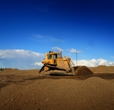 Wollert has a comprehensive approach to ensuring all asbestos is handled at the highest environmental standard.
Wollert has a comprehensive approach to ensuring all asbestos is handled at the highest environmental standard.
This includes photographing eighty-five percent of all commercial asbestos loads to carefully monitor the delivery process. These photographs are also passed back to the customer if the waste is not properly wrapped and habitual offenders are banned from the site.
Wollert only accepts commercial asbestos materials that arrive with EPA Transport Certificates, wrapped twice in plastic, within strict weight restrictions and in a Ro-Ro bin so they can be slid on an angle into the landfill, rather than being dropped onto the ground.
In areas of the tip where asbestos is being received or handled, air-quality is monitored twice a year. To date, has asbestos fibres have never been more than 1/10th of the Occupational Health and Safety limits.
Asbestos is buried the day it arrives on-site and with the GPS coordinates of each asbestos load tracked, Wollert therefore has an ongoing record of exactly where asbestos is located within the landfill.